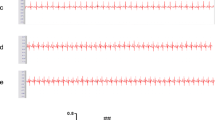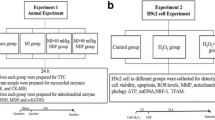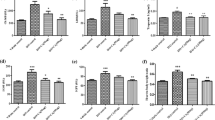Abstract
The aim of the study was to examine the protective effects and possible mechanism of gossypin against isoproterenol (ISO)-mediated myocardial damage in vivo and H9c2 cell damage in vitro. H9c2 cells were categorized into five groups. Viability was evaluated with MTT and LDH release in H9c2 cells. Apoptotic parameter analysis was performed with cytochrome c (Cyt-c), caspase-3 (CASP-3), and BCL2/Bax mRNA expression levels. In vivo, gossypin was administered orally to mice at doses of 5, 10, and 20 mg/kg for 7 days. ISO groups were injected with isoproterenol (150 mg/kg) subcutaneously (on 8th and 9th) for 2 days. Afterward, lactate dehydrogenase (LDH), creatine kinase-MB (CK-MB) levels and Troponin-I (Tn-I) amount from their serum, oxidative stress parameters superoxide dismutase (SOD) activity, glutathione (GSH) and malondialdehyde (MDA) levels, and tumor necrosis factor-α (TNF-α), interleukin-6 (IL-6), interleukin-1β (IL-1 β), and NF-kB mRNA expression levels with inflammatory markers from heart tissue were evaluated. In addition, IL-1B, BCL-2, and cas-3 immunohistochemical staining was performed from heart tissue and TNF-a level was measured by ELISA method. Administration of Gossypin protected the cells by dose-dependent, eliminating the reduced cell viability and increased LDH release of ISO in H9c2 cells. In mice serum analyses, increased LDH, CK-MB levels, and Tn-I levels were normalized by gossypin. ISO administration in heart tissue is regulated by gossypin with increased SOD activity, GSH amount, TNF-α, IL-6, IL-1β, and NF-kB mRNA expression levels and decreased MDA amount. Overall, the present results demonstrated that gossypin has a potential cardioprotective treatment for ischemic heart disease on in vivo and in vitro.






Similar content being viewed by others

Data Availability
Data that support the plots within this publication and other findings of this study are available from the corresponding author upon reasonable request.
References
Yang, H., Carasso, S., Woo, A., Jamorski, M., Nikonova, A., Wigle, E. D., & Rakowski, H. (2010). Hypertrophy pattern and regional myocardial mechanics are related in septal and apical hypertrophic cardiomyopathy. Journal of the American Society of Echocardiography, 23, 1081–1089.
Chiong, M., Wang, Z. V., Pedrozo, Z., Cao, D. J., Troncoso, R., Ibacache, M., Criollo, A., Nemchenko, A., Hill, J. A., & Lavandero, S. (2011). Cardiomyocyte death: Mechanisms and translational implications. Cell Death Disease, 2, e244.
Ong, S. B., Hernandez-Resendiz, S., Crespo-Avilan, G. E., Mukhametshina, R. T., Kwek, X. Y., Cabrera-Fuentes, H. A., & Hausenloy, D. J. (2018). Inflammation following acute myocardial infarction: Multiple players, dynamic roles, and novel therapeutic opportunities. Pharmacology & Therapeutics, 186, 73–87.
Sawyer, D. B., Siwik, D. A., Xiao, L., Pimentel, D. R., Singh, K., & Colucci, W. S. (2002). Role of oxidative stress in myocardial hypertrophy and failure. Journal of Molecular and Cellular Cardiology, 34, 379–388.
Neri, M., Fineschi, V., Di Paolo, M., Pomara, C., Riezzo, I., Turillazzi, E., & Cerretani, D. (2015). Cardiac oxidative stress and inflammatory cytokines response after myocardial infarction. Current Vascular Pharmacology, 13, 26–36.
Cinar, I., Halici, Z., Dincer, B., Sirin, B., & Cadirci, E. (2020). The role of 5-HT7 receptors on isoproterenol-induced myocardial infarction in rats with high-fat diet exacerbated coronary endothelial dysfunction. Human and Experimental Toxicology, 1, 96032712.
Krishnamurthy, P., Subramanian, V., Singh, M., & Singh, K. (2007). Beta1 integrins modulate beta-adrenergic receptor-stimulated cardiac myocyte apoptosis and myocardial remodeling. Hypertension, 49, 865–872.
Gabriel, A. S., Martinsson, A., Wretlind, B., & Ahnve, S. (2004). IL-6 levels in acute and post myocardial infarction: Their relation to CRP levels, infarction size, left ventricular systolic function, and heart failure. European Journal of Internal Medicine, 15, 523–528.
Yang, J., Wang, Z., & Chen, D. L. (2017). Shikonin ameliorates isoproterenol (ISO)-induced myocardial damage through suppressing fibrosis, inflammation, apoptosis and ER stress. Biomedicine & Pharmacotherapy, 93, 1343–1357.
Karin, M., & Delhase, M. (2000). The I kappa B kinase (IKK) and NF-kappa B: Key elements of proinflammatory signalling. Seminars in Immunology, 12, 85–98.
Xu, F., Sun, S., Wang, X., Ni, E., Zhao, L., & Zhu, W. (2017). GRK2 mediates arginine vasopressin-induced interleukin-6 production via nuclear factor-kappaB signaling neonatal rat cardiac fibroblast. Molecular Pharmacology, 92, 278–284.
Du, G., Sun, L., Zhao, R., Du, L., Song, J., Zhang, L., He, G., Zhang, Y., & Zhang, J. (2016). Polyphenols: Potential source of drugs for the treatment of ischaemic heart disease. Pharmacology & Therapeutics, 162, 23–34.
Sedighi, M., Sewell, R. D. E., Nazari, A., Abbaszadeh, S., Cheraghi, M., Amini, A., Heydari, Z., & Rafieian-Kopaei, M. (2019). A review on the most important medicinal plants effective in cardiac ischemia-reperfusion injury. Current Pharmaceutical Design, 25, 352–358.
Cinar, I. (2020). Apoptosis-inducing activity and antiproliferative effect of gossypin on PC-3 prostate cancer cells. Anti-Cancer Agents in Medicinal Chemistry, 21(4), 445–450.
Viswanathan, S., Thirugnanasambantham, P., Ramaswamy, S., & Bapna, J. S. (1993). A study on the role of cholinergic and gamma amino butyric acid systems in the anti-nociceptive effect of gossypin. Clinical and Experimental Pharmacology and Physiology, 20, 193–196.
Cinar, I., Sirin, B., Aydin, P., Toktay, E., Cadirci, E., Halici, I., & Halici, Z. (2019). Ameliorative effect of gossypin against acute lung injury in experimental sepsis model of rats. Life Sciences, 221, 327–334.
Gautam, P., & Flora, S. J. (2010). Oral supplementation of gossypin during lead exposure protects alteration in heme synthesis pathway and brain oxidative stress in rats. Nutrition, 26, 563–570.
Ugan, R. A., Cadirci, E., Halici, Z., Toktay, E., & Cinar, I. (2018). The role of urotensin-II and its receptors in sepsis-induced lung injury under diabetic conditions. European Journal of Pharmacology, 818, 457–469.
Cadirci, E., Ugan, R. A., Dincer, B., Gundogdu, B., Cinar, I., Akpinar, E., & Halici, Z. (2019). Urotensin receptors as a new target for CLP induced septic lung injury in mice. Naunyn-Schmiedeberg’s Archives of Pharmacology, 392, 135–145.
Lobo Filho, H. G., Ferreira, N. L., Sousa, R. B., Carvalho, E. R., Lobo, P. L., & Lobo Filho, J. G. (2011). Experimental model of myocardial infarction induced by isoproterenol in rats. Revista Brasileira de Cirurgia Cardiovascular, 26, 469–476.
Granata, R., Trovato, L., Gallo, M. P., Destefanis, S., Settanni, F., Scarlatti, F., Brero, A., Ramella, R., Volante, M., Isgaard, J., Levi, R., Papotti, M., Alloatti, G., & Ghigo, E. (2009). Growth hormone-releasing hormone promotes survival of cardiac myocytes in vitro and protects against ischaemia-reperfusion injury in rat heart. Cardiovascular Research, 83, 303–312.
Zaugg, M., Xu, W., Lucchinetti, E., Shafiq, S. A., Jamali, N. Z., & Siddiqui, M. A. (2000). Beta-adrenergic receptor subtypes differentially affect apoptosis in adult rat ventricular myocytes. Circulation, 102, 344–350.
Ning, B. B., Zhang, Y., Wu, D. D., Cui, J. G., Liu, L., Wang, P. W., Wang, W. J., Zhu, W. L., Chen, Y., & Zhang, T. (2017). Luteolin-7-diglucuronide attenuates isoproterenol-induced myocardial injury and fibrosis in mice. Acta Pharmacologica Sinica, 38, 331–341.
Sahu, B. D., Putcha, U. K., Kuncha, M., Rachamalla, S. S., & Sistla, R. (2014). Carnosic acid promotes myocardial antioxidant response and prevents isoproterenol-induced myocardial oxidative stress and apoptosis in mice. Molecular and Cellular Biochemistry, 394, 163–176.
Zhang, H. J., Chen, R. C., Sun, G. B., Yang, L. P., Zhu, Y. D., Xu, X. D., & Sun, X. B. (2018). Protective effects of total flavonoids from Clinopodium chinense (Benth.) O. Ktze on myocardial injury in vivo and in vitro via regulation of Akt/Nrf2/HO-1 pathway. Phytomedicine, 40, 88–97.
Meeran, M. F., & Prince, P. S. (2012). Protective effects of thymol on altered plasma lipid peroxidation and nonenzymic antioxidants in isoproterenol-induced myocardial infarcted rats. Journal of Biochemical and Molecular Toxicology, 26, 368–373.
Kannan, M. M., & Quine, S. D. (2013). Ellagic acid inhibits cardiac arrhythmias, hypertrophy and hyperlipidaemia during myocardial infarction in rats. Metabolism Clinical and Experimental, 62, 52–61.
Evran, B., Karpuzoglu, H., Develi, S., Kalaz, E. B., Soluk-Tekkesin, M., Olgac, V., Dogru-Abbasoglu, S., & Uysal, M. (2014). Effects of carnosine on prooxidant-antioxidant status in heart tissue, plasma and erythrocytes of rats with isoproterenol-induced myocardial infarction. Pharmacological Reports, 66, 81–86.
Fernandez, S. P., Nguyen, M., Yow, T. T., Chu, C., Johnston, G. A., Hanrahan, J. R., & Chebib, M. (2009). The flavonoid glycosides, myricitrin, gossypin and naringin exert anxiolytic action in mice. Neurochemical Research, 34, 1867–1875.
Thangaiyan, R., Robert, B. M., Arjunan, S., Govindasamy, K., & Nagarajan, R. P. (2018). Preventive effect of apigenin against isoproterenol-induced apoptosis in cardiomyoblasts. Journal of Biochemical and Molecular Toxicology, 32, e22213.
Konukoglu, D., Serin, O., Demiriz Kemerli, G., Serin, E., Hayirhoglu, A., & Oner, B. (1998). A study on the carotid artery intima-media thickness and its association with lipid peroxidation. Clinica Chimica Acta, 277, 91–98.
Hanukoglu, I. (2006). Antioxidant protective mechanisms against reactive oxygen species (ROS) generated by mitochondrial P450 systems in steroidogenic cells. Drug Metabolism Reviews, 38, 171–196.
Birben, E., Sahiner, U. M., Sackesen, C., Erzurum, S., & Kalayci, O. (2012). Oxidative stress and antioxidant defense. World Allergy Organization Journal, 5, 9–19.
Yilmaz, S., Atessahin, A., Sahna, E., Karahan, I., & Ozer, S. (2006). Protective effect of lycopene on adriamycin-induced cardiotoxicity and nephrotoxicity. Toxicology, 218, 164–171.
Gautam, A., & Vijayaraghavan, R. (2007). Prophylactic effect of gossypin against percutaneously administered sulfur mustard. Biomedical and Environmental Sciences, 20, 250–259.
Zhao, L., Wu, D., Sang, M., Xu, Y., Liu, Z., & Wu, Q. (2017). Stachydrine ameliorates isoproterenol-induced cardiac hypertrophy and fibrosis by suppressing inflammation and oxidative stress through inhibiting NF-kappaB and JAK/STAT signaling pathways in rats. International Immunopharmacology, 48, 102–109.
Baldissera, M. D., Souza, C. F., Grando, T. H., Stefani, L. M., & Monteiro, S. G. (2017). beta-caryophyllene reduces atherogenic index and coronary risk index in hypercholesterolemic rats: The involvement of cardiac oxidative damage. Chemico-Biological Interactions, 270, 9–14.
Hu, K., Gong, X., Ai, Q., Lin, L., Dai, J., Cai, L., Jiang, R., Ge, P., & Zhang, L. (2017). Endogenous AMPK acts as a detrimental factor in fulminant hepatitis via potentiating JNK-dependent hepatocyte apoptosis. Cell Death Disease, 8, e2637.
Campbell, K. J., & Tait, S. W. G. (2018). Targeting BCL-2 regulated apoptosis in cancer. Open Biology, 8, 15002.
Maes, M. E., Schlamp, C. L., & Nickells, R. W. (2017). BAX to basics: How the BCL2 gene family controls the death of retinal ganglion cells. Progress in Retinal and Eye Research, 57, 1–25.
Cui, C., Cui, N., Wang, P., Song, S., Liang, H., & Ji, A. (2015). Sulfated polysaccharide isolated from the sea cucumber Stichopus japonicus against PC12 hypoxia/reoxygenation injury by inhibition of the MAPK signaling pathway. Cellular and Molecular Neurobiology, 35, 1081–1092.
Yan, S. H., Zhao, N. W., Geng, Z. R., Shen, J. Y., Liu, F. M., Yan, D., Zhou, J., Nie, C., Huang, C. C., & Fang, Z. Y. (2018). Modulations of Keap1-Nrf2 signaling axis by TIIA ameliorated the oxidative stress-induced myocardial apoptosis. Free Radical Biology & Medicine, 115, 191–201.
Wang, L., Wang, X., Chen, H., Zu, X., Ma, F., Liu, K., Bode, A. M., Dong, Z., & Kim, D. J. (2019). Gossypin inhibits gastric cancer growth by direct targeting of AURKA and RSK2. Phytotherapy Research, 33, 640–650.
Bhaskaran, S., Dileep, K. V., Deepa, S. S., Sadasivan, C., Klausner, M., Krishnegowda, N. K., Tekmal, R. R., VandeBerg, J. L., & Nair, H. B. (2013). Gossypin as a novel selective dual inhibitor of v-raf murine sarcoma viral oncogene homolog B1 and cyclin-dependent kinase 4 for melanoma. Molecular Cancer Therapeutics, 12, 361–372.
Kunnumakkara, A. B., Nair, A. S., & Ahn, K. S. (2013). Gossypin, a pentahydroxy glucosyl flavone, inhibits the transforming growth factor beta-activated kinase-1-mediated NF-kappa B activation pathway, leading to potentiation of apoptosis, suppression of invasion, and abrogation of osteoclastogenesis (vol 109, pg 5112, 2007). Blood, 122, 1327–1328.
Author information
Authors and Affiliations
Contributions
IC and MY conceptualized and designed the research. TT, ETPB, RAU, and HH performed most of the experiments and analyzed the data with the help from IC and MY. IC and MY wrote the manuscript.
Corresponding author
Ethics declarations
Conflict of Interests
The authors declare that they have no conflict of interest.
Ethical Approval
All applicable international, national, and/or institutional guidelines for the care and use of animals were followed.
Additional information
Handling Editor: Jianyong Ma.
Publisher's Note
Springer Nature remains neutral with regard to jurisdictional claims in published maps and institutional affiliations.
Rights and permissions
About this article
Cite this article
Cinar, I., Yayla, M., Tavaci, T. et al. In Vivo and In Vitro Cardioprotective Effect of Gossypin Against Isoproterenol-Induced Myocardial Infarction Injury. Cardiovasc Toxicol 22, 52–62 (2022). https://doi.org/10.1007/s12012-021-09698-3
Received:
Accepted:
Published:
Issue Date:
DOI: https://doi.org/10.1007/s12012-021-09698-3



